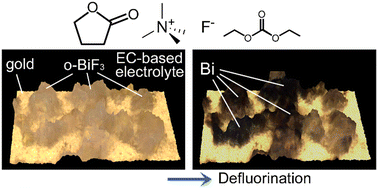Evolution of fluoride shuttle battery reactions and three-dimensional morphology changes of BiF3 microparticles in an ethylene carbonate-based liquid electrolyte†
Abstract
Fluoride shuttle batteries (FSBs) use defluorination of metal fluorides and fluorination of metals, and they are considered as candidates of next-generation batteries with high energy densities. During FSB reactions of orthorhombic and cubic BiF3 (o-BiF3 and c-BiF3, respectively) in an ethylene carbonate-based liquid electrolyte, in situ Raman mapping and in situ laser scanning confocal microscopy (LSCM) for three-dimensional analysis were conducted almost simultaneously. As the potential of o-BiF3vs. Pb (EWE) was decreased to 0.4 V, desorption of F− started at the protrusions of o-BiF3 particles. After defluorination, EWE was increased to 0.6 V, and c-BiF3 appeared at protrusions of the surfaces of Bi. However, at the surfaces where o-BiF3 partially remained, o-BiF3 grew rather than c-BiF3. The apparent volumes of particles increased during defluorination and fluorination. The results are important for determining reaction mechanisms, and the results indicate the possibility of the use of ethylene carbonate-based liquid electrolytes.



 Please wait while we load your content...
Please wait while we load your content...